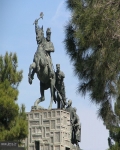Statue Of Nader Shah
Archaeology »
Archaeological Monuments » Statue Of Nader Shah
Statue Of Nader Shah -
Statue Of Nader Shah is located in Mashhad City,Khorasan Province.
Statue Of Nader Shah monument was established on 1688.
Primary threats to Statue Of Nader Shah :
Statue Of Nader Shah, Mashhad City, Khorasan Province, Iran Statue of Nader Shah Afshar the last great Asian military conqueror. Because of Nader's military genius, some historians have described him as the Napoleon of Persia Reign
Historical facts of Statue Of Nader Shah :
- The Statue of Nader Shah, an awe-inspiring monument established in 1688, stands as a testament to the remarkable historical figure it honors and the rich legacy of Persia. Situated in the heart of Isfahan, Iran, this majestic statue has captured the imagination of countless visitors with its grandeur and the historical significance it represents.
- Nader Shah, born in 1688 in the northeastern region of Iran, rose from humble beginnings to become one of Persia's most celebrated rulers. He ascended to power during a tumultuous period marked by internal strife and external invasions. Nader Shah's military prowess and strategic brilliance allowed him to unify Persia under his rule and embark on an ambitious campaign to expand the empire's borders.
- The construction of the Statue of Nader Shah was commissioned by his successors to immortalize his achievements and commemorate his reign. Standing tall at over 25 feet, the bronze statue depicts the victorious emperor in a warrior's stance, holding a sword aloft in his right hand, and his left hand resting on a globe, symbolizing his dominion over vast territories.
- Historically, Nader Shah's reign was marked by several notable accomplishments. His military campaigns were legendary, with one of the most remarkable being the successful invasion of India in 1739. The Persian army's defeat of the Mughal Empire at the Battle of Karnal not only showcased Nader Shah's tactical genius but also allowed him to plunder untold riches, including the famous Koh-i-Noor diamond and the Peacock Throne.
- Nader Shah's conquests extended beyond India; he pushed the Persian Empire's boundaries to its zenith, encompassing territories from the Caucasus in the northwest to Central Asia in the northeast. During his rule, Persia enjoyed a period of economic prosperity, cultural flourishing, and advancements in administrative reforms.
- However, Nader Shah's later years were marked by internal strife and political challenges. His tyrannical methods and heavy-handed rule led to discontent among various factions within the empire. In 1747, he was tragically assassinated, leaving behind a complex legacy of both triumphs and turmoil.
- The Statue of Nader Shah serves not only as a physical representation of the emperor but also as a symbol of Persian identity and cultural pride. Locals and tourists alike visit the monument to pay homage to this formidable ruler and to connect with the history of Persia's illustrious past.
- Over the centuries, the statue has faced its share of challenges. Time and environmental factors have taken their toll on the bronze sculpture, necessitating multiple restorations to preserve its grandeur. Despite these obstacles, the Statue of Nader Shah stands tall, a powerful reminder of the enduring spirit of Persia and its remarkable historical heritage.
- The monument has also witnessed various political and social changes in Iran's modern history. It has served as a gathering point for protests, a symbol of national unity, and a reflection of the nation's pride and aspirations. The statue's enduring presence through different epochs highlights its importance in the collective memory of the Iranian people.
- In conclusion, the Statue of Nader Shah, erected in 1688, represents a potent symbol of Persian glory and historical significance. Depicting the great emperor in a heroic stance, it immortalizes his remarkable achievements and the golden era of Persia's history. As visitors from around the world continue to marvel at its grandeur, the statue serves as a testament to the resilience and splendor of the Persian civilization.

